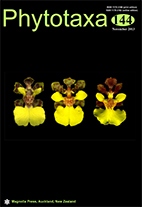Abstract
A putative natural hybrid between Cohniella ascendens and C. brachyphylla (Orchidaceae, Oncidiinae) from western Costa Rica, C. ×francoi, is herein newly described, illustrated and characterized based upon both morphological and anatomical characters. This taxon hybrid is most similar to C. ascendens but the flowers show intermediate characters between the putative parents. Cohniella ×francoi is similar to C. ascendens in its semipendulous inflorescences, callus shape, cylindrical column base with linear oblong wings, and obovate stigmatic cavity plus several anatomical characters. On the other hand, it is similar to C. brachyphylla in the oblong to subquadrate lateral lobes of the labellum that are in the same plane as the central lobe, and the rectangular disc of the labellum with a lateral extension of the callus in the margins. A table of diagnostic characters for the new hybrid and its putative parents, a comparative figure, and a map showing their geographical distributions are also provided.
Cohniella ×francoi, un híbrido natural entre Cohniella ascendens y C. brachyphylla (Orchidaceae, Oncidiinae) del oeste de Costa Rica es aquí descrito, ilustrado y caracterizado por caracteres morfológicos y anatómicos. El nuevo híbrido es más similar a C. ascendens pero las flores presentan caracteres intermedios entre sus padres putativos. Cohniella ×francoi se parece a C. ascendens en la inflorescencia semipéndula, la forma del callo, la columna cilíndrica con las alas linear oblongas y la cavidad estigmática obovada, además de varios caracteres anatómicos. Por otro lado, es similar a C. brachyphylla por los lóbulos laterales del labelo oblongos a subcuadrados y extendidos en el mismo plano que el lóbulo central y el disco rectangular con extensiones laterales del callo en los márgenes. Adicionalmente, proporcionamos una tabla de caracteres diagnósticos para el nuevo híbrido y sus padres putativos, una figura comparativa y un mapa detallando las distribuciones geográficas de los tres taxones.

